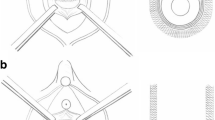Abstract
The purpose of this cross-sectional study was to evaluate patients’ satisfaction and urodynamic findings in women undergoing pubovaginal fascial sling procedure. We have evaluated, clinically and urodynamically, 45 women who underwent the rectus fascia pubovaginal sling for urodynamically proven stress urinary incontinence with at least 12 months of postoperative follow-up. After a mean follow-up of 25 months, 93.3% of patients reported being stress continent and 73.3% were satisfied with the result of the surgery. Patients with longer follow-up had a significantly lower satisfaction score (6.4 vs. 9.3, p = 0.005). Using the Blaivas–Groutz nomogram, some degree of obstruction was observed in 51.1% of women. Storage symptoms were related to obstruction (p = 0.004), longer follow-up (p = 0.022), and negative impact on quality of life. Half of the patients had some degree of obstruction, which was directly related to urge syndrome and decrease in quality of life.
Similar content being viewed by others
References
Bezerra CA, Bruschini H, Cody DJ (2005) Traditional suburethral sling operations for urinary incontinence in women. Cochrane Database Syst Rev (3):CD001754
Chaikin DC, Rosenthal J, Blaivas JG (1998) Pubovaginal fascial sling for all types of stress urinary incontinence: long-term analysis. J Urol 160(4):1312–1316
McGuire EJ, Lytton B (1978) Pubovaginal sling procedure for stress incontinence. J Urol 119(1):82–84
Blaivas JG, Appell RA, Fantl JA, Leach G, McGuire EJ, Resnick NM et al (1997) Standards of efficacy for evaluation of treatment outcomes in urinary incontinence: recommendations of the Urodynamic Society. Neurourol Urodyn 16(3):145–147
Blaivas JG, Olsson CA (1988) Stress incontinence: classification and surgical approach. J Urol 139(4):727–731
Fulford SC, Flynn R, Barrington J, Appanna T, Stephenson TP (1999) An assessment of the surgical outcome and urodynamic effects of the pubovaginal sling for stress incontinence and the associated urge syndrome. J Urol 162(1):135–137
Morgan DM, Dunn RL, Fenner DE, Faerber G, DeLancey JO, McGuire EJ et al (2007) Comparative analysis of urinary incontinence severity after autologous fascia pubovaginal sling, pubovaginal sling and tension-free vaginal tape. J Urol 177(2):604–608; discussion 608–609
Blaivas JG, Groutz A (2000) Bladder outlet obstruction nomogram for women with lower urinary tract symptomatology. Neurourol Urodyn 19(5):553–564
Leng WW, Chancellor MB (2004) Recognition and treatment of bladder outlet obstruction after sling surgery. Rev Urol 6(1):29–33
Kelleher CJ, Cardozo LD, Khullar V, Salvatore S (1997) A new questionnaire to assess the quality of life of urinary incontinent women. Br J Obstet Gynaecol 104(12):1374–1379
Tamanini JT, D’Ancona CA, Botega NJ, Rodrigues Netto N Jr (2003) Validation of the Portuguese version of the King’s Health Questionnaire for urinary incontinent women. Rev Saude Publica 37(2):203–211
Leach GE, Dmochowski RR, Appell RA, Blaivas JG, Hadley HR, Luber KM et al (1997) Female Stress Urinary Incontinence Clinical Guidelines Panel summary report on surgical management of female stress urinary incontinence. The American Urological Association. J Urol 158(3 Pt 1):875–880
Flynn BJ, Yap WT (2002) Pubovaginal sling using allograft fascia lata versus autograft fascia for all types of stress urinary incontinence: 2-year minimum follow up. J Urol 167(2 Pt 1):608–612
Sander P, Sorensen F, Lose G (2007) Does the tension-free vaginal tape procedure (TVT) affect the voiding function over time? Pressure-flow studies 1 year and 3(1/2) years after TVT. Neurourol Urodyn 26(7):995–997
Bradley CS, Rovner ES (2004) Urodynamically defined stress urinary incontinence and bladder outlet obstruction coexist in women. J Urol 171(2 Pt 1):757–760; discussion 760–751
Nitti VW (2005) Pressure flow urodynamic studies: the gold standard for diagnosing bladder outlet obstruction. Rev Urol 7(Suppl 6):S14–S21
Nitti VW, Tu LM, Gitlin J (1999) Diagnosing bladder outlet obstruction in women. J Urol 161(5):1535–1540
Defreitas GA, Zimmern PE, Lemack GE, Shariat SF (2004) Refining diagnosis of anatomic female bladder outlet obstruction: comparison of pressure-flow study parameters in clinically obstructed women with those of normal controls. Urology 64(4):675–679; discussion 679–681
Akikwala TV, Fleischman N, Nitti VW (2006) Comparison of diagnostic criteria for female bladder outlet obstruction. J Urol 176(5):2093–2097
Conflicts of interest
None
Author information
Authors and Affiliations
Corresponding author
Rights and permissions
About this article
Cite this article
Toledo, L.G.M., Korkes, F., Romero, F.R. et al. Bladder outlet obstruction after pubovaginal fascial sling. Int Urogynecol J 20, 201–205 (2009). https://doi.org/10.1007/s00192-008-0759-8
Received:
Revised:
Accepted:
Published:
Issue Date:
DOI: https://doi.org/10.1007/s00192-008-0759-8




